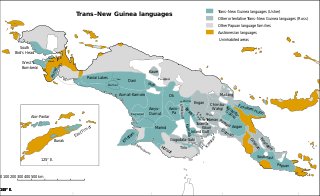Related Research Articles

Trans–New Guinea (TNG) is an extensive family of Papuan languages spoken in New Guinea and neighboring islands, perhaps the third-largest language family in the world by number of languages. The core of the family is considered to be established, but its boundaries and overall membership are uncertain. The languages are spoken by around 3 million people. There have been three main proposals as to its internal classification.
Maria is a Manubaran language spoken in the "Bird's Tail" of Papua New Guinea by approximately 1,350 people in Central Province. It is alternatively known as Gebi and Manubara.
Amanab is a Papuan language spoken by 4,400 people in Amanab District, Sandaun Province, Papua New Guinea.
Q with hook tail is a letter of the extended Latin alphabet. It was introduced by Lutheran missionaries in Papua New Guinea for use in the Numanggang language in the 1930s or 1940s. In 2002, it was decided to discontinue using Q with hook tail. It is still used in the Kâte language to represent a voiced labial-velar plosive.
Kara is an Austronesian language spoken by about 5,000 people in 1998 in the Kavieng District of New Ireland Province, Papua New Guinea.
Kâte is a Papuan language spoken by about 6,000 people in the Finschhafen District of Morobe Province, Papua New Guinea. It is part of the Finisterre–Huon branch of the Trans–New Guinea language family. It was adopted for teaching and mission work among speakers of Papuan languages by the Evangelical Lutheran Church of Papua New Guinea in the early 1900s and at one time had as many as 80,000 second-language speakers.
The Dagan or Meneao Range languages are a small family of Trans–New Guinea languages spoken in the Meneao Range of the "Bird's Tail" of New Guinea, the easternmost Papuan languages on the mainland. They are the most divergent of the several small families within the Southeast Papuan branch of Trans–New Guinea.
The Kwalean or Humene–Uare languages are a small family of Trans–New Guinea languages spoken in the "Bird's Tail" of New Guinea. They are classified within the Southeast Papuan branch of Trans–New Guinea.
The Koiarian languages Koiari are a small family of Trans–New Guinea languages spoken in the "Bird's Tail" of New Guinea. They are classified within the Southeast Papuan branch of Trans–New Guinea.

The Southeast Papuan or Papuan Peninsula languages are a group of half a dozen small families of Papuan languages in the "Bird's Tail" of New Guinea that are part of the Trans–New Guinea (TNG) phylum.
The Anuki language is an Austronesian language spoken by the Gabobora people along Cape Vogel in the Milne Bay Province of Papua New Guinea. The language was named after a highly respected deity of the people, whose sacred remains now rest in Australia.
Bargam, or Mugil, is a Papuan language of Madang Province, Papua New Guinea, spoken mainly by adults. It is divergent within the Madang language family.
Kube (Hube) and Tobo, also Mongi, are a Papuan language spoken in Morobe Province, Papua New Guinea. They are mutually intelligible and 95% lexicostatistically cognate. Dialects of Kube include Kurungtufu and Yoangen (Yoanggeng).
Binandere is a Papuan language spoken in the "tail" of Papua New Guinea.
Ewage, also known as Notu, is a Papuan language spoken in the "tail" of Papua New Guinea. Preference for the name depends on the region. Its two dialects are Sose/Sohe and Ifane/Ihane.
Humeme is a language of the "Bird's Tail" of Papua New Guinea. It is spoken mainly in and around the village of Manugoro in Rigo Central Rural LLG, Central Province.
Suena is a Papuan language spoken in Morobe Province, in the "tail" of Papua New Guinea. It is part of the Binanderean family of the Trans–New Guinea phylum of languages.
Baruga, also known ambiguously as Bareji, is a Papuan language spoken in Oro Province, in the "tail" of Papua New Guinea. The four rather divergent dialects are Tafota, Daghoro, Bareji, Mado. They are part of the Binanderean family of the Trans–New Guinea phylum of languages.
Nawaru, or Sirio, is a Papuan language. It is spoken in the village of Sibia in Namudi ward, Safia Rural LLG, Ijivitari District, Oro Province, in the "tail" of Papua New Guinea.

The Papuan Peninsula, also known as the Bird's Tail Peninsula, is a large peninsula in Papua New Guinea, southeast of the city of Lae, that makes up the southeastern portion of the island of New Guinea. The peninsula is the easternmost extent of the New Guinea Highlands and consists largely of the Owen Stanley Range, with peaks such as Mount Victoria and Mount Suckling. On the south coast is Port Moresby, the capital and largest city of Papua New Guinea.
References
- 1 2 Numanggang at Ethnologue (18th ed., 2015) (subscription required)
- ↑ Lorna A. Priest, Revised Proposal for Additional Latin Phonetic and Orthographic Characters, 2004